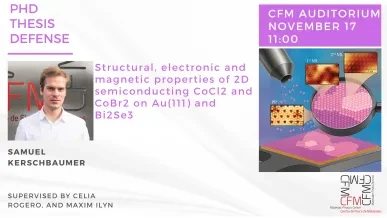PhD Thesis Defense | Samuel Kerschbaumer
Samuel Kerschbaumer
CFM
CFM Auditorium
Supervisors: Celia Rogero, and Maxim Ilyn

Evaporation and deposition of CoBr₂ onto a Au(111) crystal showing regular layer-by-layer growth. Atomic-resolution STM images illustrate the structure of each phase: precursor phase (PP), first monolayer (1st ML), and second monolayer (2nd ML).
With the rise of quantum technologies, the field of quantum physics is gaining even greater interest, promising new devices for processing, storing and transmitting information through effects such as superposition, entanglement and quantum confinement. Integrating these into functional devices requires not only advances in quantum theory but also in material science. Within this research field, surface sensitive measurement techniques provide powerful tools to control materials at the nanometer scale, enabling a precise characterization of their structural,
electronic and magnetic properties. This control is particularly important for exploring proximity-induced effects, where the behavior of a material can be modified by its contact with another system. For example, this can happen at topological insulator-ferromagnet interfaces, potentially resulting in resistanceless transport through topologically protected edge states. Achieving such effects requires ultra-high-vacuum as well as optimized growth conditions, ensuring flat, clean and chemically well-defined interfaces, free from contaminants. Combining
synthesis with advanced characterization tools provides the foundation for engineering and enhancing the quantum functionalities needed in next-generation devices.
This thesis in particular investigates the growth, electronic structure and magnetism of the cobalt dihalides CoCl2 and CoBr2, two semiconducting van der Waals magnets from the family of transition metal dihalides that can be synthesized by molecular beam epitaxy at substrate temperatures compatible with silicon processing (∼100 ◦C). These films were first grown on Au(111) to resolve early-stage growth and interactions on a well-known substrate and then on the topological insulator Bi2Se3. Local probes such as scanning tunneling microscopy provided
atomic scale information on morphology and crystallinity, while spatially averaged spectroscopic techniques gave insights into electronic structure, chemical composition and magnetism.
For CoCl2, we show that it grows into well-ordered trilayers that extend over step edges and are isostructural to the bulk material, preserving a semiconducting gap and exhibiting a robust in-plane magnetic anisotropy at low temperature. For CoBr2, we find that growth proceeds through a stable and electrically conductive precursor phase at submonolayer coverage, which subsequently reorganizes into the bulk-like trilayers. Surprisingly, upon rearrangement, these become semiconducting and display a similar in-plane spin alignment as CoCl2. These experiments were complemented by machine learning driven calculations, allowing us to hypothesize
a growth model for the evolution from submonolayer adsorption to crystalline monolayers.
This work demonstrates that cobalt dihalides can be stabilized as atomically thin semiconducting magnets with well-defined in-plane anisotropy, placing them among the few 2D systems where magnetism and semiconducting behavior coexist at the monolayer limit. By revealing their growth mechanism and interfacial behavior, this thesis lays the foundation for using CoCl2 and CoBr2 as building blocks in van der Waals heterostructures. The development of quantum devices where magnetism, topology and electron correlation can be tuned, is a key step towards future technologies.
